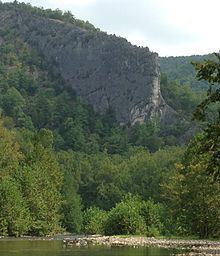Type sedimentary | Thickness 250+/-20 m Named by E. O. Ulrich, 1911 Primary Limestone | |
 | ||
Named for Tonoloway Ridge, Rock Ford, WV | ||
Roadcut of keyser and tonoloway formations
The Late Silurian Tonoloway Formation is a mapped limestone bedrock unit in Pennsylvania, Maryland, Virginia and West Virginia.
Contents
- Roadcut of keyser and tonoloway formations
- Description
- Depositional environment
- Notable exposures
- Age
- References
Description
The basal 50 m consists of medium-dark-gray laminated to thin-bedded calcisiltite with shale partings and interbeds. Overlying 5 m are light-yellowish-gray to olive-gray mudstone and shale. Above this interval are 75 m of laminated calcisiltite with interbeds of thick to very thick bedded calcisiltite. The remainder of the formation is cyclic, consisting of three or four resistant ledges of laminated limestone and shale. Uppermost 20 m contains a variety of limestones. Lower contact with the Wills Creek is probably conformable. Upper contact is conformable and undulatory, occurring at the base of the "calico" limestone of the Keyser Formation.
Depositional environment
The depositional environment of the Tonoloway is interpreted as shallow marine.
Notable exposures
Age
Relative age dating places the Tonoloway in the late Silurian.
